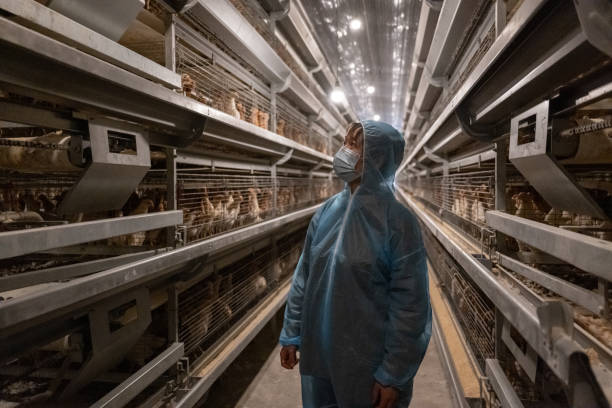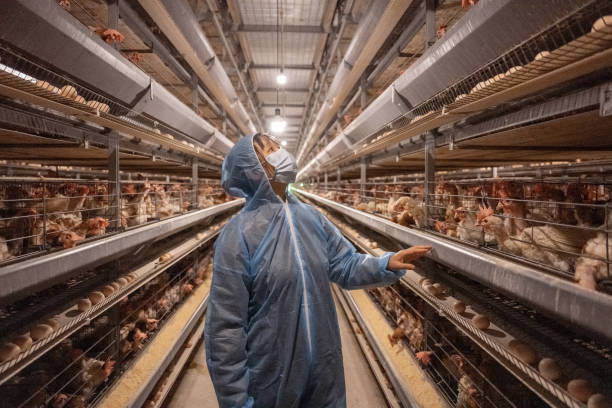Investing in Battery Chicken Cages for a 30000-Bird Poultry Farm in Uganda: A Comprehensive Guide
Investing in Battery Chicken Cages for a 30000-Bird Poultry Farm in Uganda: A Comprehensive Guide
Uganda’s poultry industry is experiencing impressive growth, fueled by rising demand for eggs and chicken meat. For aspiring and established poultry farmers alike, maximizing efficiency and profitability is paramount. Investing in the right equipment is crucial, and battery chicken cages have emerged as a popular choice for large-scale operations. If you’re considering establishing a 30000-bird poultry farm in Uganda and exploring battery cages, this comprehensive guide will provide you with the necessary information to make an informed decision.
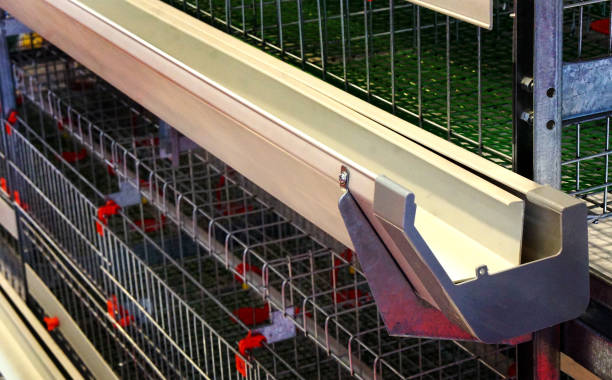
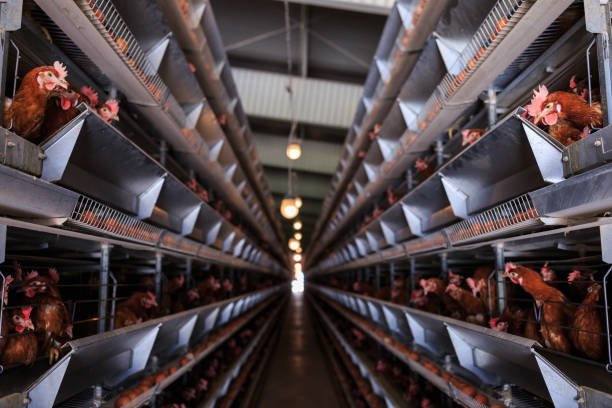
Understanding Battery Chicken Cages
Battery cages, also known as layer cages or broiler cages depending on their use, are a housing system designed to accommodate multiple chickens in individual or small group compartments. These cages are typically arranged in rows and tiers, creating a multi-level structure that optimizes space utilization. The design allows for efficient feeding, watering, and waste removal, contributing to improved hygiene and management.
Why Choose Battery Cages for a 30000-Bird Farm?
Several compelling reasons make battery cages an attractive option for large-scale poultry farms like a 30000-bird operation in Uganda:
Space Optimization: One of the most significant advantages is the efficient use of space. Battery cages allow you to house a large number of birds in a relatively small area compared to free-range or deep litter systems. This is particularly important in areas where land is a limited or expensive resource. For a 30000-bird farm, space efficiency translates to lower land acquisition costs and reduced infrastructure expenses.
Improved Management and Monitoring: Battery cage systems simplify management practices. Individual or small group housing makes it easier to monitor each bird’s health, identify potential problems early, and implement targeted interventions. This reduces the risk of disease outbreaks and improves overall flock health.
Enhanced Egg Production (for Layers): For egg-laying hens, battery cages provide a controlled environment that can optimize egg production. Factors such as lighting, temperature, and feed distribution can be precisely managed to maximize egg output. The sloping floors in many battery cage designs facilitate easy egg collection, minimizing breakage and contamination.
Reduced Feed Wastage: With individual feeding troughs or systems, battery cages minimize feed wastage. Chickens have limited access to scratching or spilling feed, which translates to significant cost savings, especially in large-scale operations like a 30000-bird farm where feed costs represent a substantial portion of the overall expenses.
Better Hygiene and Disease Control: The design of battery cages, often with wire mesh floors, allows for easy removal of manure. This reduces the build-up of ammonia and other harmful gases, improving air quality and minimizing the risk of respiratory diseases. Regular cleaning and disinfection are also easier to implement in battery cage systems.
Labor Efficiency: Automated feeding, watering, and egg collection systems (in some advanced cages) significantly reduce labor requirements. This is particularly beneficial in Uganda, where labor costs can be a significant factor. Reduced labor translates to lower operational costs and improved efficiency.
Factors to Consider Before Investing in Battery Cages
Before making a final decision, it’s essential to carefully consider the following factors:
Cage Types: There are various types of battery cages available, including A-frame cages, H-frame cages, and flat deck cages. Each type has its own advantages and disadvantages in terms of cost, space utilization, and management requirements. A-frame cages are generally more affordable and easier to install, while H-frame cages offer better space utilization and ventilation. Flat deck cages are often used for broiler production.
Cage Material and Construction: The quality of the cage material and construction directly affects its durability and lifespan. Galvanized steel is a common material for battery cages due to its resistance to corrosion and rust. Ensure that the cages are well-built with sturdy frames and smooth surfaces to prevent injuries to the birds.
Cage Size and Bird Density: The size of the cage and the number of birds housed per cage are crucial factors that affect bird welfare and productivity. It’s important to comply with animal welfare regulations and ensure that each bird has sufficient space to move, feed, and rest comfortably. Overcrowding can lead to stress, disease outbreaks, and reduced production. Aim for densities that promote healthy and productive birds
Ventilation and Climate Control: Maintaining optimal ventilation and temperature is essential for bird health and productivity. Poor ventilation can lead to a build-up of ammonia and other harmful gases, while extreme temperatures can cause stress and reduce egg production. Invest in proper ventilation systems, such as fans and air inlets, to ensure a comfortable and healthy environment for your birds. Consider climate control technologies, like cooling pads, depending on Uganda’s specific geographic climate.
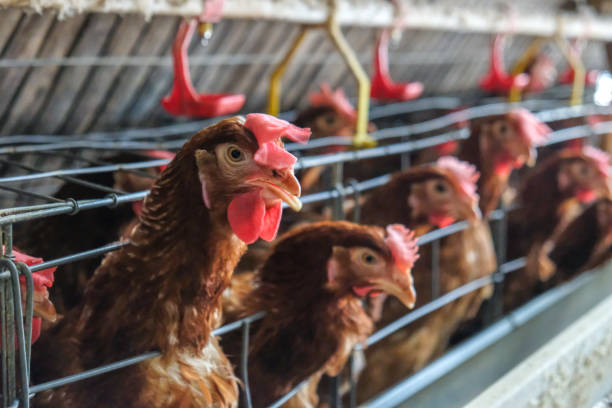
Feeding and Watering Systems: Choose efficient feeding and watering systems that minimize wastage and ensure that all birds have access to adequate feed and water. Automatic feeding and watering systems can significantly reduce labor requirements and improve feed conversion efficiency. Nipple drinkers are a popular choice for battery cages as they minimize water spillage and contamination.
Manure Removal Systems: Efficient manure removal is crucial for maintaining good hygiene and preventing disease outbreaks. Options include manual scraping, belt manure removal systems, and flushing systems. Belt manure removal systems are a popular choice for large-scale battery cage operations as they automatically remove manure on a regular basis.
Egg Collection Systems (for Layers): If you are raising egg-laying hens, consider investing in automated egg collection systems. These systems gently collect eggs and transport them to a central collection point, minimizing breakage and contamination.
Biosecurity Measures: Implementing strict biosecurity measures is essential to prevent disease outbreaks. This includes controlling access to the farm, disinfecting equipment and vehicles, and implementing a vaccination program. Foot baths, hand sanitizers, and protective clothing should be provided for all personnel entering the poultry house.
Environmental Impact: Consider the environmental impact of your battery cage operation. Proper manure management is essential to prevent pollution of soil and water resources. Explore options for composting or using manure as fertilizer to minimize its environmental impact.
Regulatory Compliance: Ensure that your poultry farm complies with all relevant regulations and standards in Uganda. This includes obtaining the necessary permits and licenses, complying with animal welfare regulations, and adhering to environmental protection standards. Local authorities will have specific requirements regarding building codes, waste disposal, and biosecurity measures.
Sourcing Your Battery Chicken Cages
Once you have a clear understanding of your requirements, it’s time to start sourcing your battery chicken cages. Consider the following options:
Local Manufacturers and Suppliers: Look for reputable manufacturers and suppliers in Uganda or neighboring countries. Local suppliers can offer competitive prices and provide after-sales service and support.
International Suppliers: Consider importing battery cages from international suppliers, particularly those in China, which often offers competitive pricing. Ensure the supplier can provide quality products that meet your specific requirements. Thoroughly research the supplier’s reputation and track record before making a purchase and understand import duties and logistical considerations.
Online Marketplaces: Explore online marketplaces such as Alibaba to find suppliers of battery chicken cages. Exercise caution when purchasing from online marketplaces and verify the supplier’s credentials before committing to a purchase.
Installation and Maintenance
Proper installation and maintenance are essential for ensuring the longevity and performance of your battery chicken cages. Follow the manufacturer’s instructions carefully during installation and perform regular maintenance to prevent breakdowns and extend the lifespan of the equipment.
Professional Installation: Consider hiring a professional installer to ensure that the battery cages are properly installed and aligned. Poor installation can lead to problems with feeding, watering, and manure removal.
Regular Cleaning: Clean the cages regularly to remove manure, feathers, and other debris. This helps to maintain good hygiene and prevent the spread of diseases.
Lubrication: Lubricate moving parts, such as hinges and latches, to prevent wear and tear.
Inspection: Inspect the cages regularly for signs of damage, such as rust, cracks, or broken wires. Repair or replace damaged parts promptly to prevent injuries to the birds.
Water System Maintenance: Flush and clean the water system regularly to prevent the build-up of algae and bacteria.
Financial Considerations
Investing in battery chicken cages represents a significant financial investment. Develop a detailed business plan that includes a financial analysis of the costs and benefits of using battery cages.
Initial Investment Costs: Include the cost of the battery cages, ventilation systems, feeding and watering systems, manure removal systems, egg collection systems (if applicable), and installation costs.
Operating Costs: Include the cost of feed, water, electricity, labor, veterinary services, and other operating expenses.
Revenue Projections: Estimate your revenue based on egg production (for layers) or meat production (for broilers) and the prevailing market prices.
Return on Investment (ROI): Calculate the ROI to determine the profitability of your investment.
Financing Options: Explore financing options such as bank loans, microfinance, or government subsidies to help cover the initial investment costs.
Animal Welfare Considerations
While battery cages offer numerous benefits in terms of efficiency and management, it’s important to consider animal welfare concerns. Ensure that the cages provide adequate space for the birds to move, feed, and rest comfortably. Provide enrichment items, such as perches or dust baths, to improve the birds’ quality of life. Some modern battery cage designs include enriched features that allow for more natural behaviors.
Conclusion
Investing in battery chicken cages for a 30000-bird poultry farm in Uganda can be a profitable venture if done correctly. By carefully considering the factors outlined in this guide, you can make an informed decision and choose the right battery cage system for your specific needs. Remember to prioritize bird welfare, comply with regulations, and implement sound management practices to ensure the success of your poultry farm. With proper planning and execution, your 30000-bird poultry farm in Uganda can thrive and contribute to the growing demand for poultry products in the region. The keys include careful consideration of cage types, environmental control, biosecurity, along with sound financial planning and responsible animal welfare practices.



